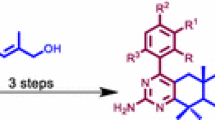Abstract
While screening for potential anti-inflammatory natural product scaffolds, alantolactone (1) was found to attenuate LPS-induced pro-inflammatory mediators in RAW264.7 macrophage cells. In this regard, a series of 17 novel thiol derivatives of 1 has been synthesized and evaluated as inhibitors of pro-inflammatory mediators viz. NO (nitric oxide), IL-6 (interleukin-6), and TNF-α (tumor necrosis factor-α) in LPS-treated RAW264.7 macrophage cells (In vitro) and female Balb/C mice (in vivo). In vitro, the best inhibition potencies were obtained with compounds 3, 4, 6, and 18, which were selected for further in vivo testing. The results of in vivo studies revealed that compounds 3, 6, and 18 are comparable to that of the parent molecule 1 on the inhibition of TNF-α and IL-6 release, whereas compound 4 was identified as the most potent inhibitor of cytokines IL-6 (69.49%) and TNF-α (66.12%) as compared with 1 at dose 10 mg/kg. Taken together, our results suggest that thiol analogs of 1 have therapeutic potential and could be further explored for potential anti-inflammatory activity.



Similar content being viewed by others
References
Cantrell CL, Abate L, Fronczek FR, Franzblau SG, Quijano L, Fischer NH (1999) Antimycobacterial eudesmanolides from Inula helenium and Rudbeckia subtomentosa. Planta Med 65:351–355
Chun J, Choi RJ, Khan S, Lee DS, Kim YC, Nam YJ, Lee DU, Kim YS (2012) Alantolactone suppresses inducible nitric oxide synthase and cyclooxygenase-2 expression by down-regulating NF-kappaB, MAPK and AP-1 via the MyD88 signaling pathway in LPS-activated RAW 264.7 cells. Int Immunopharmacol 14:375–383
Gao S, Wang Q, Tian X-H, Li H-L, Shen Y-H, Xu X-K, Wu G-Z, Hu Z-L, Zhang W-D (2017) Total sesquiterpene lactones prepared from Inula helenium L. has potentials in prevention and therapy of rheumatoid arthritis. J Ethnopharmacol 196:39–46
Gupta S, Khajuria V, Wani A, Nalli Y, Bhagat A, Ali A, Ahmed Z (2018) Murrayanine attenuates lipopolysaccharide-induced inflammation and protects mice from sepsis-associated organ failure. Basic Clin Pharmacol Toxicol. https://doi.org/10.1111/bcpt.13032.
Lim HS, Jin SE, Kim OS, Shin HK, Jeong SJ (2015) Alantolactone from Saussurea lappa exerts antiinflammatory effects by inhibiting chemokine production and STAT1 phosphorylation in TNF-α and IFN-gamma-induced in HaCaT cells. Phytother Res 29:1088–1096
Ma Y-Y, Zhao D-G, Gao K (2013) Structural investigation and biological activity of sesquiterpene lactones from the traditional chinese herb Inula racemosa. J Nat Prod 76:564–570
Maryam A, Mehmood T, Zhang H, Li Y, Khan M, Ma T (2017) Alantolactone induces apoptosis, promotes STAT3 glutathionylation and enhances chemosensitivity of A549 lung adenocarcinoma cells to doxorubicin via oxidative stress. Sci Rep 7:6242
Nalli Y, Gupta S, Khajuria V, Singh VP, Sajgotra M, Ahmed Z, Thakur NL, Ali A (2017) TNF-α and IL-6 inhibitory effects of cyclic dipeptides isolated from marine bacteria Streptomyces sp. Med Chem Res 26:93–100
Nalli Y, Khajuria V, Gupta S, Arora P, Riyaz-Ul-Hassan S, Ahmed Z, Ali A (2016) Four new carbazole alkaloids from Murraya koenigii that display anti-inflammatory and anti-microbial activities. Org Biomol Chem 14:3322–3332
Picman AK, Schneider EF (1993) Inhibition of fungal growth by selected sesquiterpene lactones. Biochem Syst Ecol 21:307–314
Seca AM, Grigore A, Pinto DC, Silva AM (2014) The genus Inula and their metabolites: from ethnopharmacological to medicinal uses. J Ethnopharmacol 154:286–310
Seo JY, Lim SS, Kim JR, Lim JS, Ha YR, Lee IA, Kim EJ, Park JH, Kim JS (2008) Nrf2-mediated induction of detoxifying enzymes by alantolactone present in Inula helenium. Phytother Res 22:1500–1505
Wang X, Yu Z, Wang C, Cheng W, Tian X, Huo X, Wang Y, Sun C, Feng L, Xing J, Lan Y, Sun D, Hou Q, Zhang B, Ma X, Zhang B (2017) Alantolactone, a natural sesquiterpene lactone, has potent antitumor activity against glioblastoma by targeting IKKβ kinase activity and interrupting NF-κB/COX-2-mediated signaling cascades. J Exp Clin Cancer Res: CR 36:93
Yuliya P, Bakhtiyor R, Vladimir S, Zainab K, Jerzy L (2009) Structure‐hepatoprotective activity relationship study of sesquiterpene lactones: a QSAR analysis. Int J Quantum Chem 109:17–27
Zhao P, Pan Z, Luo Y, Zhang L, Li X, Zhang G, Zhang Y, Cui R, Sun M, Zhang X (2015) Alantolactone induces apoptosis and cell cycle arrest on lung squamous cancer SK-MES-1 cells. J Biochem Mol Toxicol 29:199–206
Acknowledgements
CK and AK acknowledge AcSIR for their enrollment in PhD program. We would like to acknowledge the Ministry of AYUSH (New Delhi) for providing financial support for the work of Y. K (Z.28015/229/2015-HCP EMR). The article bears the institutional manuscript no. IIIM/2281/2019.
Author information
Authors and Affiliations
Corresponding author
Ethics declarations
Conflict of interest
The authors declare that they have no conflict of interest.
Additional information
Publisher’s note: Springer Nature remains neutral with regard to jurisdictional claims in published maps and institutional affiliations.
Supplementary information
Rights and permissions
About this article
Cite this article
Kumar, C., Kumar, A., Nalli, Y. et al. Design, synthesis and biological evaluation of alantolactone derivatives as potential anti-inflammatory agents. Med Chem Res 28, 849–856 (2019). https://doi.org/10.1007/s00044-019-02337-1
Received:
Accepted:
Published:
Issue Date:
DOI: https://doi.org/10.1007/s00044-019-02337-1




